TETRA APS 50 Aquarium Air Pump
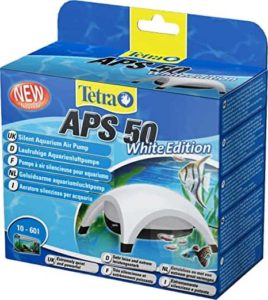 This air pump is inexpensive and suitable for 10 to 60 liters of aquariums. The flow rate is adjustable to suit your aquarium.
This air pump is inexpensive and suitable for 10 to 60 liters of aquariums. The flow rate is adjustable to suit your aquarium.
It may not be the most elegant pump on the market, but it works well and gets the job done for a competitive price.
It’s not the quietest on the market but the quietest in its class. It is equipped with a triple anti-noise system.
The Tetra APS 50 is available in white or black.
It is delivered without an air hose or non-return valve. This seems logical considering its price. So you should plan to buy them in addition to the pump.
EHEIM 400 Aquarium Air Pump
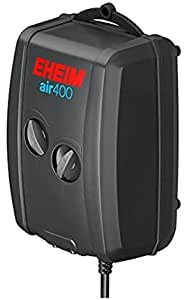 This air pump is suitable for large aquariums. Therefore, it should generate a lot of noise.
This air pump is suitable for large aquariums. Therefore, it should generate a lot of noise.
This is not the case. This Eheim pump is the quietest of its kind and generates only 40 dB. That’s very little for the performance it delivers.
The Eheim brand is known for its quality and reliability.
With this pump, you get 2 non-return valves and 2 meters of hose. Its small rubber feet allow excellent stability and especially avoid any vibration noise. It is also equipped with a suspension ring to hang on a wall.
The power is adjustable. However, it is impossible to cut off the airflow completely.
The EHEIM 100 aquarium air pump
 The Eheim 3701 aquarium air pump is powerful and very quiet. It is suitable for aquariums up to 100 liters and is a very quiet and energy-saving pump. It consumes only 3.5 W on average.
The Eheim 3701 aquarium air pump is powerful and very quiet. It is suitable for aquariums up to 100 liters and is a very quiet and energy-saving pump. It consumes only 3.5 W on average.
When you buy this aquarium air pump, it comes complete with a one-meter air hose and an EHEIM diffuser. It also includes a non-return valve.
The airflow and diffuser are adjustable, allowing you to produce different types of bubbles to suit your taste and the aquarium’s needs. It will enable you to create a boil in the diffuser.
The EHEIM air pump is equipped with a suspension ring for wall mounting. It can also be laid flat thanks to its “anti-vibration” rubber foot, which reduces the movements often caused by vibrations.
The bedee aquarium air pump
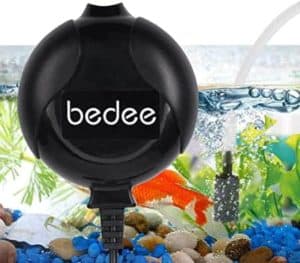 The bedee air pump is a mini-pump ideal for small aquariums of less than 50 liters with a water level below 60 centimeters. The flow rate is 450 ml/minute.
The bedee air pump is a mini-pump ideal for small aquariums of less than 50 liters with a water level below 60 centimeters. The flow rate is 450 ml/minute.
This pump is very quiet. Indeed, it is driven by a thin piezoelectric ceramic plate. The noise level does not exceed 35 dB, and the brand promises that you will not hear anything when you are more than 50 cm away from this pump.
So it can be placed in a living room, an office, or a bedroom.
It is also very energy efficient. Indeed, it consumes only 1 W.
It is installed on the walls of aquariums thanks to its suction cups, which avoid vibration problems and the risk of the pump falling.
JBL Aquarium Air Pump – PROSILENT A400
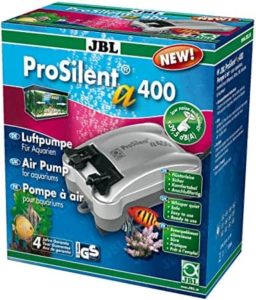 This air pump is quiet and designed for large freshwater and saltwater aquariums from 200 to 600 liters. It is very efficient and offers an airflow rate of 400 l/h and air pressure of over 160 mbar. It is very energy efficient. It consumes only 5.5 W.
This air pump is quiet and designed for large freshwater and saltwater aquariums from 200 to 600 liters. It is very efficient and offers an airflow rate of 400 l/h and air pressure of over 160 mbar. It is very energy efficient. It consumes only 5.5 W.
The air outlet can be adjusted.
It offers a high degree of safety thanks to an air intake with a screwed hose connection.
For the quiet side, it has a soundproof air chamber, reinforced pump body walls, and anti-vibration rubber feet.
When you buy this pump, it comes with a 2-meter air hose (90° swivel) and a non-return valve.
The NICREW aquarium air pump
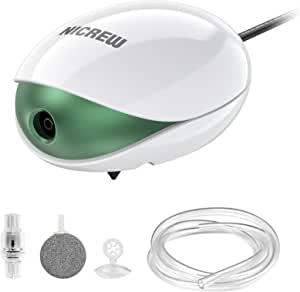 This air pump is small but very powerful. It can produce a constant and powerful airflow of 4 L/min. In addition, it is very energy efficient, consuming only 1.7 W. It is suitable for small and medium-sized aquariums. It will be effective for freshwater and saltwater aquariums from 10 to 100 liters.
This air pump is small but very powerful. It can produce a constant and powerful airflow of 4 L/min. In addition, it is very energy efficient, consuming only 1.7 W. It is suitable for small and medium-sized aquariums. It will be effective for freshwater and saltwater aquariums from 10 to 100 liters.
It emits very little noise thanks to its reinforced shell and anti-vibration rubber feet. It emits only 35 dB and will not disturb your daily life.
This air pump will come with an air hose, bubble stones, suction cup, and check valve.
It is recommended to install the check valve between the pump and the diffuser. In case of power failure, this will prevent water from flowing back into the hose and damaging the motor.
Tetra EX 800 Plus Aquarium Air Pump
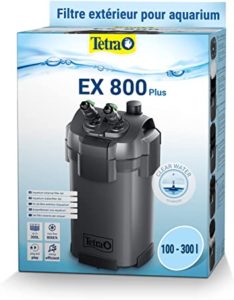 This air pump is more expensive than all the others presented. However, it offers unmatched performance. It is extremely powerful and quiet for its size.
This air pump is more expensive than all the others presented. However, it offers unmatched performance. It is extremely powerful and quiet for its size.
This pump is designed for aquariums from 100 to 300 liters.
It offers the particularity of having a multi-stage filter, with 5 filtration plates, for optimal water sanitation. Its installation is a bit more complex, but the installation manual is clear, and if you follow it well, you should not have any difficulties. The brand has made tutorials in French on its Facebook page to help you with the installation.
You can adjust the flow rate with its control valves. It has a safety system that allows you to stop and block the water flow in case of problems. The taps are adjustable to help you position the pipes.
It is easily disassembled for optimal regular maintenance.
Plan to purchase or dedicate a suitable cabinet as this pump is large and requires a dedicated area.
How do I maintain an aquarium aerator?
To increase the life of your air pump, but also to limit wear and tear and, therefore, the appearance of noise, you must maintain it.
Here’s how to effectively maintain your aquarium air pump:
Maintain the filter:
As with any device that has a filter, it needs to be cleaned regularly to keep it running efficiently.
Anti-pollution filters are more expensive but will be more effective.
Maintain the membranes:
The membranes are soft rubber and naturally wear out with use. Wear and tear will cause perforations that will decrease the efficiency of the air pump. You should replace the diaphragm as soon as it starts to wear out.
Maintain the diffuser:
Also, remember to clean the diffuser regularly because it tends to get dirty. If it is not cleaned, it will reduce the flow of air diffused and, therefore, the efficiency of your pump.
FAQ
What is an aquarium pump?
An aquarium air pump is an electronic box that circulates air in the aquarium. It also adds equipment such as bubble decorations, sponge filters, and aerodromes.
The pump must be installed outside the aquarium as it is not waterproof. It should not be in contact with the water. A hose called an “air tube” allows the water to circulate.
You can install an air pump in freshwater or saltwater aquariums.
The operation of an aquarium air pump is effortless. A lever presses on a suction cup called a membrane. This sucks the air in and pushes it out of the air pump. This creates movement and thus circulation.
What is an aquarium pump used for?
The aquarium air pump is not used for the well-being of the fish living in the aquarium.
It is used to power other accessories in your aquarium.
Air-fed accessories require a pump and will not work if you do not have one. Examples are bubble decorations and sponge filters.
Different types of aquarium pumps
There are different types of aquarium air pumps. They are distinguished by the kind of power supply they use.
Mains-powered air pumps.
This is the most common type of aquarium pump. These pumps are powered by electricity.
The pump must be plugged in and turned on. It will run continuously and does not have an on/off switch. To stop the pump from running, it must be unplugged.
Battery-powered air pumps
Unlike the first type, these pumps do not require electrical power. They run on batteries.
These pumps are useful if your aquarium is too far from a power outlet or as a supplement to a mains-powered pump.
However, they are rarely the primary pumps because they are noisier and consume a lot of batteries.
Air pumps with battery backup
These are hybrid pumps. That means you can turn it on by plugging it in, but it also has a built-in battery backup that runs on batteries. This allows you to run continuously, even if the power goes out.
Criteria for choosing the right aquarium pump
The size of the aquarium
The size of the aquarium is the first thing to look at and what will define the size of the pump you need. The larger the aquarium, the more powerful the pump will need to be.
The air pump in your aquarium should be powerful enough to create pressure on the volume of water in your aquarium.
If you plan to add accessories, it should be even more powerful. The flow rate should be at least equal to the volume of water in the aquarium.
For example, for a 100-liter aquarium, you need an air pump with a minimum flow rate of 100 L/h.
Choosing a more powerful air pump will ensure that your added accessories work correctly and last longer. Your pump will have fewer problems and will not tire as quickly.
The sound volume generated by the air pump
As we have said, your aquarium air pump should not become a nightmare for your ears and living comfort. Therefore, you should pay attention to the sound power generated. This article will introduce you to the quietest air pumps on the market.
Replacement of spare parts.
Some components wear out over time and can be replaced without changing the air pump.
It’s essential to ensure you can easily find these parts to replace them.
You can replace the filter, the diaphragm, the hose, or the pump core.
What to do if your aquarium pump is too noisy?
Do you already have an air pump for your aquarium, but it’s too noisy and interferes with your comfort?
You can try a few easy techniques to reduce the noise from your pump. You may not have to buy a new one.
Techniques for older air pumps
Aging air pumps make more and more noise as they age.
There are 3 things you can do to reduce the noise of this pump.
Replace the diaphragm.
Diaphragms are made of rubber and will eventually wear out. If your pump is suitable for your aquarium, it is recommended to change it yearly. If your pump is not powerful enough, it must be replaced regularly.
You can buy a new one. Be sure to purchase the right brand of the diaphragm for your pump to make sure it’s compatible.
Tighten the screws.
Over time, the vibrations generated by the air pump tend to loosen the inner screws.
Try to tighten them properly to limit the possibility of noise. This will only take a few minutes and can make a difference.
Techniques for new air pumps.
If you just bought a brand new air pump for your aquarium but can’t stand the noise, you should try these tips. These techniques are designed for soundproofing your new pump.
Place the pump on foam.
The foam blocks will dampen the vibrations and reduce the noise. There are foam blocks that you can cut to fit your air pump. Also, cut two grooves for the power cable and hose.
Insulate the inner compartment.
In many air pumps, there is space in the inner compartments. This is especially true of the less expensive pumps. This empty area contributes to the noise of your pump by amplifying the vibrations. If you insulate the inner compartment, the vibrations will be significantly reduced, and the noise of your pump will be much lower.
To do this, unscrew the pump to access the compartment. Fill in the gaps and screw the pump back on.
Put the pump on a towel or pillow.
It’s not the most aesthetically pleasing, but it’s an economical technique.
You can place your pump on a folded towel or pillow. The vibrations generated by the pump will be dampened. The noise is muffled, and the pump will not move.
Conclusion
You will never have a completely silent pump. Indeed, its operation inevitably generates noise.
However, by choosing the suitable model, this noise will not bother you because it will be less.
You will avoid unpleasant vibrations and rattles by choosing a silent pump.
You must consider these criteria
- and the device’s power to make your choice. It is expressed in liters of air/hour and must be adapted to the volume of your aquarium.
- Its noise level is essential, depending on the room where your aquarium is installed. Generally speaking, buying a quiet air pump is more pleasant even if the aquarium is not close to your living space.
- Its build quality and performance.
- The ability to modulate the flow. Most pumps have this feature, but check it before you buy.
- Availability of replacement parts. You must have easy access to parts that can be changed in case of a breakdown and regular maintenance.
You can also use our techniques to significantly reduce the noise generated by the aquarium air pump you already have without having to buy a new one.
